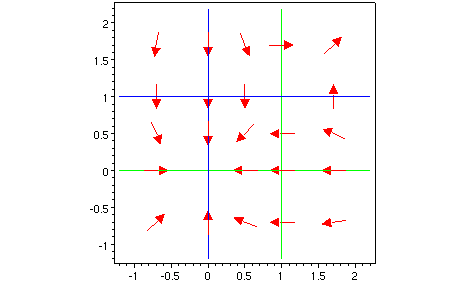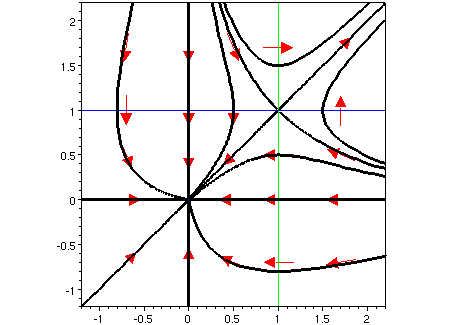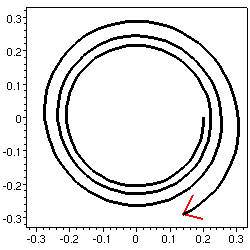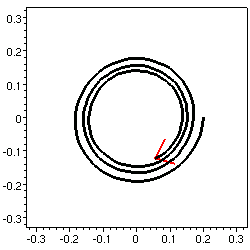How To Draw Phase Portraits Of Nonlinear Systems
Phase Portraits of Nonlinear Systems
Consider aHere are some of the principles of trajectory sketching:
The linear approximation to a part of 2 variables ![]() about a indicate
about a indicate ![]() is
is

Nosotros desire to practise this in item at an equilibrium point, where

where the matrix
![]()
is called the Jacobian of the vector field
Example: Consider the system
![]() ,
,
![]() .
.
For an equilibrium point we need ![]() (i.e.
(i.e. ![]() or
or ![]() ) and
) and ![]() (i.east.
(i.east. ![]() or
or ![]() ). At that place are thus ii equilibrium points:
). At that place are thus ii equilibrium points: ![]() and
and ![]() .
.
Before classifying the equilibrium points, it's a good thought to describe the isoclines for ![]() and
and ![]() . I'll plot the get-go in bluish and the second in green. I indicate with arrows the direction field in each region and on the isoclines. The intersections of the blueish and dark-green isoclines are the equilibrium points.
. I'll plot the get-go in bluish and the second in green. I indicate with arrows the direction field in each region and on the isoclines. The intersections of the blueish and dark-green isoclines are the equilibrium points.

The Jacobian matrix is  . At the equilibrium point
. At the equilibrium point ![]() this is
this is  . That has a double eigenvalue
. That has a double eigenvalue ![]() , and two linearly contained eigenvectors. Therefore the equilibrium point
, and two linearly contained eigenvectors. Therefore the equilibrium point ![]() is a atypical node, and is an attractor.
is a atypical node, and is an attractor.
At the 2d equilibrium point ![]() the Jacobian matrix is
the Jacobian matrix is  . This has eigenvalues i and
. This has eigenvalues i and ![]() . Therefore the equilibrium bespeak
. Therefore the equilibrium bespeak ![]() is a saddle. The eigenvectors are
is a saddle. The eigenvectors are ![]() for 1 and
for 1 and  for
for ![]() . The picture beneath shows the phase aeroplane with some parts of trajectories near the two equilibrium points. Note that the directions of these trajectories agree with the management field arrows from the previous movie.
. The picture beneath shows the phase aeroplane with some parts of trajectories near the two equilibrium points. Note that the directions of these trajectories agree with the management field arrows from the previous movie.

Now nosotros sketch some trajectories. There are trajectories on the ![]() and
and ![]() axes (going in to the equilibrium point at the origin), because
axes (going in to the equilibrium point at the origin), because ![]() when
when ![]() and
and ![]() when
when ![]() . Next it'due south a good idea to sketch the trajectories coming out of and going in to the saddle point. For instance, 1 comes in to the saddle point from beneath and to the right. We go backwards in time, following the arrows backward. These arrows point up and left in the region
. Next it'due south a good idea to sketch the trajectories coming out of and going in to the saddle point. For instance, 1 comes in to the saddle point from beneath and to the right. We go backwards in time, following the arrows backward. These arrows point up and left in the region ![]() ,
,  . The trajectory must curve to avert the trajectory on the positive
. The trajectory must curve to avert the trajectory on the positive ![]() centrality. It is presumably asymptotic to that axis. The trajectory coming out of the saddle bespeak downward and to the left must proceed down and to the left until it ends at the equilibrium betoken
centrality. It is presumably asymptotic to that axis. The trajectory coming out of the saddle bespeak downward and to the left must proceed down and to the left until it ends at the equilibrium betoken ![]() .
.

Finally, we draw some more trajectories, including at least one in each region. Annotation that those trajectories that enter the equilibrium point at ![]() can practice and then at any angle.
can practice and then at any angle.

Our picture is symmetric about the line ![]() , because of the fact that the arrangement of equations remains the same if you interchange
, because of the fact that the arrangement of equations remains the same if you interchange ![]() and
and ![]() .
.
The trajectories entering and leaving the saddle point are separatrices. All trajectories below and to the left of the two trajectories entering the saddle go to the equilibrium point ![]() equally
equally ![]() , while those above and to the right become off to infinity asymptotic to the line
, while those above and to the right become off to infinity asymptotic to the line ![]() . Below and to the right of the trajectories leaving the saddle, everything comes in from infinity asymptotic to the positive
. Below and to the right of the trajectories leaving the saddle, everything comes in from infinity asymptotic to the positive ![]() centrality (as
centrality (as ![]() ), while in a higher place and to the left of these everything comes in from infinity asymptotic to the positive
), while in a higher place and to the left of these everything comes in from infinity asymptotic to the positive ![]() axis.
axis.
As I mentioned, in that location are two exceptions to the rule that the phase portrait about an equilibrium indicate can be classified by the linearization at that equilibrium point. The offset is where 0 is an eigenvalue of the linearization (nosotros didn't even look at the linear organisation in that example!). The second exception is where the linearization is a center. The linear organization has periodic solutions, respective to trajectories that are closed curves (ellipses). Imagine starting at some point and following the direction field. Afterward going all the mode around the equilibrium betoken, in the linear organization you return exactly to the point yous started at. This is a very delicate matter, and any nonlinear effect, fifty-fifty if very pocket-size, could spoil it. If in the nonlinear organization you come up back slightly farther away from the equilibrium point than where you started, and then your trajectory can non exist a airtight bend. The adjacent time around, you will be still farther away. The trajectory will spiral away from the equilibrium bespeak. If all trajectories about the equilibrium point are like this, the equilibrium point is an unstable screw. On the other paw, if later on one plow around the equilibrium point you are slightly closer than where y'all started, your trajectory spirals inwards. If all trajectories near the equilibrium betoken are like this, the equilibrium point is a stable spiral (and an attractor). Here are pictures of those two possibilities. The 3rd possibility, of course, is that you do come dorsum exactly to the point where you started, and it really is a centre.


One fashion to show that a center of the linearized arrangement is nonetheless a centre in the nonlinear system is to find an equation for the trajectories. If in that location is such an (implicit) equation ![]() where
where ![]() is a smoothen function, not constant in whatsoever region, and
is a smoothen function, not constant in whatsoever region, and ![]() an arbitrary constant, then the trajectories, which are level curves of this function, tin non be spirals simply tin can be closed curves. This occurs both in the predator-prey and pendulum systems.
an arbitrary constant, then the trajectories, which are level curves of this function, tin non be spirals simply tin can be closed curves. This occurs both in the predator-prey and pendulum systems.
- Nigh this document ...
Robert State of israel
2002-04-01
Source: https://www.math.ubc.ca/~israel/m215/nonlin/nonlin.html
Posted by: dewsfrept1991.blogspot.com


0 Response to "How To Draw Phase Portraits Of Nonlinear Systems"
Post a Comment